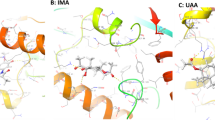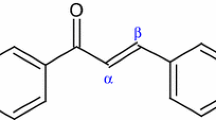Abstract
A series of tailored novobiocin–ferrocene conjugates was prepared in moderate yields and investigated for in vitro anticancer and antiplasmodial activity against the MDA-MB-231 breast cancer line and Plasmodium falciparum 3D7 strain, respectively. While the target compounds displayed moderate anticancer activity against the breast cancer cell line with IC50 values in the mid-micromolar range, compounds 10a–c displayed promising antiplasmodial activity as low as 0.889 µM. Furthermore, the most promising compounds were tested for inhibitory effects against a postulated target, heat shock protein 90 (Hsp90).
Graphical abstract
A selection of tailored novobiocin derivatives bearing the organometallic ferrocene unit were synthesized and characterized by common spectroscopic techniques. The target compounds were investigated for in vitro anticancer and antimalarial activity against the MDA-MB-231 breast cancer cell line and Plasmodium falciparum 3D7 strain, respectively.




Similar content being viewed by others
References
Marcu MG, Schulte TW, Neckers L (2000) Novobiocin and related coumarins and depletion of heat shock protein 90-dependent signaling proteins. J Natl Cancer Inst 92(3):242–248
Burlison JA, Neckers L, Smith AB, Maxwell A, Blagg BS (2006) Novobiocin: redesigning a DNA gyrase inhibitor for selective inhibition of hsp90. J Am Chem Soc 128(48):15529–15536
Burlison JA, Avila C, Vielhauer G, Lubbers DJ, Holzbeierlein J, Blagg BS (2008) Development of novobiocin analogues that manifest anti-proliferative activity against several cancer cell lines. J Org Chem 73(6):2130–2137
Donnelly AC, Mays JR, Burlison JA, Nelson JT, Vielhauer G, Holzbeierlein J, Blagg BS (2008) The design, synthesis, and evaluation of coumarin ring derivatives of the novobiocin scaffold that exhibit antiproliferative activity. J Org Chem 73(22):8901–8920
Young JC, Moarefi I, Hartl FU (2001) Hsp90: a specialized but essential protein-folding tool. J Cell Biol 154(2):267–274
Zuehlke A, Johnson JL (2010) Hsp90 and co-chaperones twist the functions of diverse client proteins. Biopolymers 93(3):211–217
Holzbeierlein JM, Windsperger A, Vielhauer G (2010) Hsp90: a drug target? Curr Oncol Rep 12(2):95–101
Pallavi R, Roy N, Nageshan RK, Talukdar P, Pavithra SR, Reddy R, Venketesh S, Kumar R, Gupta AK, Singh RK (2010) Heat shock protein 90 as a drug target against protozoan infections biochemical characterization of Hsp90 from Plasmodium falciparum and trypanosoma evansi and evaluation of its inhibitor as a candidate drug. J Biol Chem 285(49):37964–37975
Kumar R, Musiyenko A, Barik S (2003) The heat shock protein 90 of Plasmodium falciparum and antimalarial activity of its inhibitor, geldanamycin. Malar J 2(1):30
Banumathy G, Singh V, Pavithra SR, Tatu U (2003) Heat shock protein 90 function is essential for Plasmodium falciparum growth in human erythrocytes. J Biol Chem 278(20):18336–18345
Peterson LB, Blagg BS (2009) To fold or not to fold: modulation and consequences of Hsp90 inhibition. Future Med Chem 1(2):267–283
Shahinas D, Folefoc A, Pillai DR (2013) Targeting Plasmodium falciparum Hsp90: towards reversing antimalarial resistance. Pathogens 2(1):33–54
Le Bras G, Radanyi C, Peyrat J-F, Brion J-D, Alami M, Marsaud V, Stella B, Renoir J-M (2007) New novobiocin analogues as antiproliferative agents in breast cancer cells and potential inhibitors of heat shock protein 90. J Med Chem 50(24):6189–6200
Radanyi C, Le Bras G, Marsaud V, Peyrat J-F, Messaoudi S, Catelli M-G, Brion J-D, Alami M, Renoir J-M (2009) Antiproliferative and apoptotic activities of tosylcyclonovobiocic acids as potent heat shock protein 90 inhibitors in human cancer cells. Cancer Lett 274(1):88–94
Donnelly AC, Zhao H, Kusuma BR, Blagg BS (2010) Cytotoxic sugar analogues of an optimized novobiocin scaffold. Med Chem Commun 1(2):165–170
Zhao H, Donnelly AC, Kusuma BR, Brandt GE, Brown D, Rajewski RA, Vielhauer G, Holzbeierlein J, Cohen MS, Blagg BS (2011) Engineering an antibiotic to fight cancer: optimization of the novobiocin scaffold to produce anti-proliferative agents. J Med Chem 54(11):3839–3853
Mbaba M, Mabhula AN, Boel N, Edkins AL, Isaacs M, Hoppe HC, Khanye SD (2017) Ferrocenyl and organic novobiocin derivatives: synthesis and their in vitro biological activity. J Inorg Biochem 172:88–93
Raghavan PS, Kumar R, Tatu U (2007) Systems analysis of chaperone networks in the malarial parasite Plasmodium falciparum. PLoS Comput Biol 3:e168
Wang T, Bisson WH, Mäser P, Scapozza L, Picard D (2014) Differences in conformational dynamics between Plasmodium falciparum and human Hsp90 orthologues enable the structure-based discovery of pathogen-selective inhibitors. J Med Chem 57(6):2524–2535
Wang T, Mäser P, Picard D (2016) Inhibition of Plasmodium falciparum Hsp90 contributes to the antimalarial activities of aminoalcohol-carbazoles. J Med Chem 59(13):6344–6352
Bayih AG, Folefoc A, Mohon AN, Eagon S, Anderson M, Pillai DR (2016) In vitro and in vivo anti-malarial activity of novel harmine-analog heat shock protein 90 inhibitors: a possible partner for artemisinin. Malar J 15(1):579
Divo A, Sartorelli A, Patton C, Bia F (1988) Activity of fluoroquinolone antibiotics against Plasmodium falciparum in vitro. Antimicrob Agents Chemother 32(8):1182–1186
Ram ER, Kumar A, Biswas S, Kumar A, Chaubey S, Siddiqi MI, Habib S (2007) Nuclear gyrB encodes a functional subunit of the Plasmodium falciparum gyrase that is involved in apicoplast DNA replication. Mol Biochem Parasitol 154(1):30–39
Chavain N, Biot C (2010) Organometallic complexes: new tools for chemotherapy. Curr Med Chem 17(25):2729–2745
Gasser G, Metzler-Nolte N (2012) The potential of organometallic complexes in medicinal chemistry. Curr Opin Chem Biol 16(1–2):84–91
Hartinger CG, Metzler-Nolte N, Dyson PJ (2012) Challenges and opportunities in the development of organometallic anticancer drugs. Organometallics 31(16):5677–5685
Patra M, Gasser G (2017) The medicinal chemistry of ferrocene and its derivatives. Nat Rev Chem 1(9):0066
Kowalski K (2018) Recent developments in the chemistry of ferrocenyl secondary natural product conjugates. Coord Chem Rev 366:91–108
To evaluate the efficacy of a single dose regimen of ferroquine and artefenomel in adults and children with uncomplicated Plasmodium falciparum Malaria (FALCI) (2018) US National Library of Medicine. https://clinicaltrials.gov/ct2/show/NCT02497612. Accessed 28 October 2018
Top S, Tang J, Vessières A, Carrez D, Provot C, Jaouen G (1996) Ferrocenyl hydroxytamoxifen: a prototype for a new range of oestradiol receptor site-directed cytotoxics. Chem Commun 8:955–956
Jaouen G, Vessières A, Top S (2015) Ferrocifen type anti cancer drugs. Chem Soc Rev 44(24):8802–8817
Laemmli UK (1970) Cleavage of structural proteins during the assembly of the head of bacteriophage T4. Nature 227(5259):680–685
Towbin H, Staehelin T, Gordon J (1979) Electrophoretic transfer of proteins from polyacrylamide gels to nitrocellulose sheets: procedure and some applications. Proc Natl Acad Sci USA 76(9):4350–4354
Lunga MJ, Chisango RL, Weyers C, Isaacs M, Taylor D, Edkins AL, Khanye SD, Hoppe HC, Veale C (2018) Expanding the SAR of non-toxic antiplasmodial indolyl-3-ethanone ethers and thioethers. ChemMedChem 13:1353–1362
Oderinlo OO, Tukulula M, Isaacs M, Hoppe HC, Taylor D, Smith VJ, Khanye SD (2018) New thiazolidine-2, 4-dione derivatives combined with organometallic ferrocene: Synthesis, structure and antiparasitic activity. Appl Organomet Chem 32(7):e4385
Wider D, Péli-Gulli M-P, Briand P-A, Tatu U, Picard D (2009) The complementation of yeast with human or Plasmodium falciparum Hsp90 confers differential inhibitor sensitivities. Mol Biochem Parasitol 164(2):147–152
Mendelson WL, Hayden S (1996) Preparation of 2,4-dihydroxybenzaldehyde by the Vilsmeier-Haack Reaction. Synth Commun 26(3):603–610
Kudale AA, Kendall J, Warford CC, Wilkins ND, Bodwell GJ (2007) Hydrolysis-free synthesis of 3-aminocoumarins. Tetrahedron Lett 48(29):5077–5080
Nicolaou K, Bunnage ME, Koide K (1994) Total synthesis of balanol. J Am Chem Soc 116(18):8402–8403
Dunetz JR, Xiang Y, Baldwin A, Ringling J (2011) General and scalable amide bond formation with epimerization-prone substrates using T3P and pyridine. Org Lett 13(19):5048–5051
Zhao H, Reddy Kusuma B, Blagg BS (2010) Synthesis and evaluation of noviose replacements on novobiocin that manifest antiproliferative activity. ACS Med Chem Lett 1(7):311–315
Theodoraki MA, Caplan AJ (2012) Quality control and fate determination of Hsp90 client proteins. BBA Mol Cell Res 1823(3):683–688
Sittler A, Lurz R, Lueder G, Priller J, Hayer-Hartl MK, Hartl FU, Lehrach H, Wanker EE (2001) Geldanamycin activates a heat shock response and inhibits huntingtin aggregation in a cell culture model of Huntington’s disease. Hum Mol Genet 10(12):1307–1315
Dlugosz A, Janecka A (2017) Novobiocin analogs as potential anticancer agents. Mini Rev Med Chem 17(9):728–733
Acknowledgements
The authors would like to acknowledge Rhodes University Sandisa Imbewu (SDK, HCH and ALE) and the National Research Foundation (MM, JNS, ALE and SDK) for financial support. Financial assistance from South African Research Chairs Initiative of the Department of Science and Technology and National Research Foundation of South Africa (Grant No 98566) is also acknowledged (ALE). The South African Medical Research Council (MRC) funded the antiplasmodial bioassay component of the project with funds from National Treasury under its Economic Competitiveness and Support Package.
Author information
Authors and Affiliations
Corresponding authors
Ethics declarations
Conflict of interest
The authors declare that they have no conflict of interest.
Electronic supplementary material
Below is the link to the electronic supplementary material.
775_2018_1634_MOESM1_ESM.pdf
Information pertaining the synthesis and spectroscopic data of all the final compounds and intermediates investigated in this work can be found in the “Supplementary information” document (PDF 2074 kb)
Rights and permissions
About this article
Cite this article
Mbaba, M., de la Mare, JA., Sterrenberg, J.N. et al. Novobiocin–ferrocene conjugates possessing anticancer and antiplasmodial activity independent of HSP90 inhibition. J Biol Inorg Chem 24, 139–149 (2019). https://doi.org/10.1007/s00775-018-1634-9
Received:
Accepted:
Published:
Issue Date:
DOI: https://doi.org/10.1007/s00775-018-1634-9




